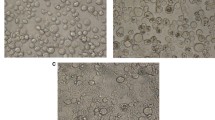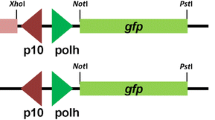Abstract
It is well known that the characteristics of cell lines possibly alter when cell lines are at high-passage number because of the environmental selection. We do not know whether non-permissive or low-permissive cell lines could become permissive or more permissive to virus infection after over-high passage. In the present studies, the alteration of the permissiveness of Spodoptera litura cell line Sl-zsu-1 to three baculovirus infection was investigated after over-high passage, and the possible mechanisms are also investigated. Vigorous apoptosis in Sl-zsu-1 cells was induced by both the recombinant Autographa californica multiple nucleopolyhedrovirus AcMNPV-GFP-actin and the celery looper Anagrapha falcifera multiple nucleopolyhedrovirus AfMNPV, suggesting the replication of the two viruses was blocked by apoptosis. However, the cells infected by S. litura multicapsid nucleopolyhedrovirus SpltMNPV did not undergo apoptosis, but the SpltMNPV titre of the supernatant was not detectable, suggesting this cell line was low-permissive for this virus infection and other factor(s) involved in blockage of the virus replication except apoptosis. However, when Sl-zsu-1 cells had been subcultured continuously for more than 4 years (high-passage cell), which was named as Sl-HP cell line afterwards, no significant apoptosis was induced by the three baculovirus in Sl-HP cells, and many replicated virions or nucleocapsids were observed in the cells. But the permissiveness of Sl-HP cells to the three viruses was very different according to the titre of viruses in the cell cultures. Interestingly, the DNA extracted from SpltMNPV could induce vigorous apoptosis of Sl-HP cells. Altogether, Sl-zsu-1 cell line becomes more permissive to baculovirus infection after over-high passage and multiple paths can block the baculovirus infectivity.







Similar content being viewed by others
Abbreviations
- SpltMNPV:
-
Spodoptera litura nucleopolyhedrovirus
- AfMNPV:
-
Anagrapha falcifera multiple nucleopolyhedrosis virus
- AcMNPV:
-
Autographa californica multiple nucleopolyhedrovirus
- AcMNPV-GFP-actin:
-
A recombinant Autographa californica multiple nucleopolyhedrovirus with a fused GFP-actin gene
References
Barros LF, Kanaseki T, Sabirov R et al (2003) Apoptotic and necrotic blebs in epithelial cells display similar neck diameters but different kinase dependency. Cell Death Differ 10(6):687–697. doi:10.1038/sj.cdd.4401236
Briske-Anderson MJ, Finley JW, Newman SM (1997) Influence of culture time and passage number on morphological and physiological development of Caco-2 cells. Proc Soc Exp Biol Med 214(3):248–257
Calles K, Svensson I, Lindskog E et al (2006) Effects of conditioned medium factors and passage number on Sf9 cell physiology and productivity. Biotechnol Prog 22(2):394–400. doi:10.1021/bp050297a
Chang S, Sun H, Li Z (1998) Effect of temperature oscillation on insect cell growth and baculovirus replication. Appl Environ Microbiol 64(6):2237–2239
Clemm DL (1992) Scale-up of protein production in a stirred bioreactor. In: O’Reilly DR, Miller LK, Luckow VA (eds) Baculovirus expression vectors: a laboratory manual. W. H. Freeman, New York, pp 241–248
Dai XJ, Pang Y, Nong G et al (1998) Is baculovirus gp64 gene a primary factor inducing apoptosis of insect cells? Acta Sci Natur Univ Sunyatseni 37(3):7–12 In Chinese
Deschesnes RG, Huot J, Valerie K et al (2001) Involvement of p38 in apoptosis-associated membrane blebbing and nuclear condensation. Mol Biol Cell 12(6):1569–1582
Donaldson MS, Shuler ML (1998) Effects on long-term passaging of BTI-Tn5B1-4 insect cells on growth and recombinant protein production. Biotechnol Prog 14(4):543–547. doi:10.1021/bp9800485
Feng G, Yu Q, Hu C et al (2007) Apoptosis is induced in the haemolymph and fat body of Spodoptera exigua larvae upon oral inoculation with Spodoptera litura nucleopolyhedrovirus. J Gen Virol 88:2185–2193. doi:10.1099/vir.0.82919-0
Hirata H, Hibasami H, Yoshida T et al (1998) Differentiation and apoptosis without DNA fragmentation in cultured Schwann cells derived from wallerian-degenerated nerve. Apoptosis 3(5):353–360. doi:10.1023/A:1009633205444
Inbal B, Bialik S, Sabanay I et al (2002) DAP kinase and DRP-1 mediate membrane blebbing and the formation of autophagic vesicles during programmed cell death. J Cell Biochem 157(3):455–468
Jia Y, Yu Z, Chen X (2005) Actin and production of AcMNPV polyhedra. Prog Biochem Biophys 32(9):829–834
Joosten CE, Shuler ML (2003) Effect of culture conditions on the degree of sialylation of a recombinant glycoprotein expressed in insect cells. Biotechnol Prog 19(3):739–749. doi:10.1021/bp0201049
Knudson DL, Tinsley TW (1974) Replication of a nuclear polyhedrosis virus in a continuous cell culture of Spodoptera frugiperda: purification, assay of infectivity, and growth characteristics of the virus. J Virol 14(4):934–944
Li X, Zhou R, Jia Y et al (2004) Function of actin in transportation of the AcMNPV from nuclear to outside of cell. Virol Sin 19(6):630–635
Liu K, Zheng J, Hong H et al (2005) Mechanisms for Bt toxin resistance and increased chemical pesticide susceptibility in Cry1Ac10-resistant cultured insect cells. Cytotechnology 49(2–3):153–160. doi:10.1007/s10616-006-6880-y
Liu L, Peng J, Liu K et al (2007a) Influence of cytochrome c on apoptosis induced by Anagrapha (Syngrapha) falcifera multiple nuclear polyhedrosis virus (AfMNPV) in insect Spodoptera litura cells. Cell Biol Int 31(9):996–1001. doi:10.1016/j.cellbi.2007.03.011
Liu K, Tang Q, Fu C et al (2007b) Influence of glucose starvation on the pathway of death in insect cell line Sl: apoptosis follows autophagy. Cytotechnology 54(2):97–105. doi:10.1007/s10616-007-9080-5
O’Reilly DR, Miller LK, Luckow VA (1992) Baculovirus expression vectors: a laboratory manual. W. H. Freeman & Company, New York
Pang Y, Yu J, Wang L et al (2001) Sequence analysis of the Spodoptera litura multicapsid nucleopolyhedrovirus genome. Virology 287(2):391–404. doi:10.1006/viro.2001.1056
Park MT, Lee MS, Kim SH et al (2004) Influence of culture passages on growth kinetics and adenovirus vector production for gene therapy in monolayer and suspension cultures of HEK 293 cells. Appl Microbiol Biotechnol 65:553–558. doi:10.1007/s00253-004-1617-3
Peiser C, Riebe-Imre M, Emura M et al (1993) Influence of culture passages on growth kinetics, xenobiotic metabolism, chromosomal stability and transformation in a clonal fetal hamster lung epithelial cell line. Mutat Res 289(2):281–290. doi:10.1016/0027-5107(93)90079-U
Rosser BG, Gores GJ (1995) Liver cell necrosis: cellular mechanisms and clinical implications. Gastroenterology 108(1):252–275. doi:10.1016/0016-5085(95)90032-2
Simon O, Williams T, Lopez-Ferber M et al (2004) Virus entry or the primary infection cycle are not the principal determinants of host specificity of Spodoptera spp. nucleopolyhedroviruses. J Gen Virol 85:2845–2855. doi:10.1099/vir.0.80179-0
Xie WD, Qu SR, Pang Y (1988) The establishment of an insect cell line from Spodoptera litura and the study of virus infection. Acta Sci Natur Univ Sunyatseni 45:113–116
Xiu M, Peng J, Hong H (2005) Mitochondrial response and calcium ion change in apoptotic insect cells induced by SfaMNPV. Chin Sci Bull 50(12):1191–1198. doi:10.1360/04WC0275
Zhang P, Yang B, Dai X et al (2002) Apoptosis of Spodoptera litura cells induced by AcMNPV ie-1 gene. Acta Biochim Biophys Sin (Shanghai) 34(6):707–711
Zheng TS, Schlosser SF, Dao T et al (1998) Caspase-3 controls both cytoplasmic and nuclear events associated with Fas-mediated apoptosis in vivo. Proc Natl Acad Sci USA 95(23):13618–13623. doi:10.1073/pnas.95.23.13618
Acknowledgement
This was supported by the Natural Science of Foundation of Hubei Province (Grant No: 2007ABA160), the National Natural Science Foundation of China (Grant No: 30470073) and the State Ministry of-Education College Students’ Innovative Projects (2007). Hong-Ye Zhang, Xin-Xue Cai and Yi-Chun Lin took part in some experimental work.
Author information
Authors and Affiliations
Corresponding author
Rights and permissions
About this article
Cite this article
Zhang, X., Lan, W., Deng, Y. et al. Highly passage of Spodoptera litura cell line causes its permissiveness to baculovirus infection. Cytotechnology 57, 233–243 (2008). https://doi.org/10.1007/s10616-008-9158-8
Received:
Accepted:
Published:
Issue Date:
DOI: https://doi.org/10.1007/s10616-008-9158-8




